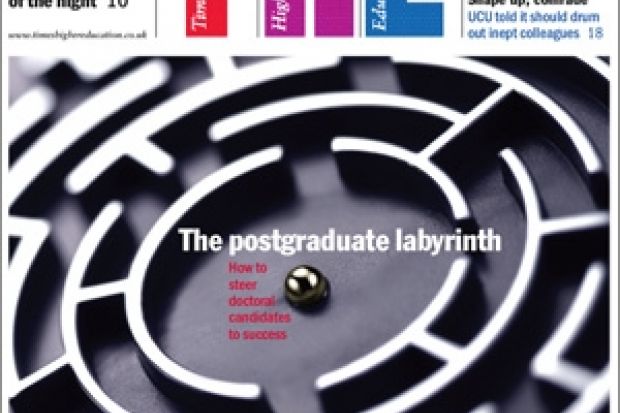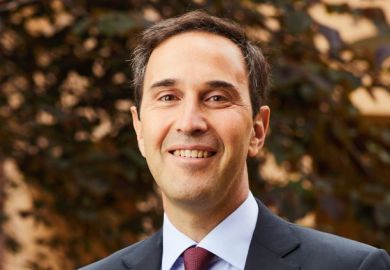Behind every failed doctoral candidature is a personal tragedy. The unsuccessful conclusion of any degree is a moment of sadness, but the scale of this disappointment is much greater in the case of doctoral students. The dream - the prize - is to enter academic life, build knowledge and supervise others. When failed candidates leave the campus for the last time, there is a darkness and chill to their journeys that should remain with all of us who care about the future of universities.
I often write about postgraduate education and supervision, but I want this feature to be haunted by the faces of those who do not complete their research. Instead of focusing on students and supervisors, I want to draw attention to the university structures that underpin doctoral education. The goal is to formulate a strategy so that warning signs are logged and help given to troubled students and supervisors. Rightly, there is a great deal of institutional emphasis on completion rates, yet behind every non-submission is the life of a student whose academic dreams have been destroyed. To help, we must improve the top-down organisational culture of doctoral education.
1. The graduate centre
The crucial first step to supporting postgraduates and increasing completion rates is to establish a centralised graduate centre. Some of the greatest universities in the world have them, and for good reason.
Too often, programmes, departments, schools and faculties fight over doctoral students and the fees they bring. Although there are resourcing issues to be considered, if students are to finish their degrees, they must be seen as more than the fees they contribute.
When a university's doctoral students are cannibalised by small sections of an institution, a research community cannot develop. Interdisciplinary links with other students and staff are more difficult to organise, and there is a wasteful replication of resources.
The advantage of a graduate centre is that the best administrative staff can be appointed. They do not have to divide their time between managing the payment and travel arrangements for staff conferences, institutional repositories or timetables. They can specialise in all stages of candidature from admission to graduation. As a result, there is continuity of care and recognition that not only is postgraduate education radically different from undergraduate education, but also that doctorates require processes distinct from those involved in coursework masters.
The budgetary commitment covering a supervisor's time, stationery and incidentals can be paid to a school or department, but by pooling a university's resources for hardware, software, aggregated library subscriptions and facilities, efficiencies are created. The key is developing a group of well-qualified, experienced and supportive administrative staff who care about doctoral students and understand their history, hopes and hardships.
2. Paper trails are vital
With a graduate centre in place, a file can be activated on and for each student. Over the three years of candidature, annual reports, conference attendance, milestone meetings and publications can be recorded. Supervisors are encouraged to log issues with the graduate centre. Students can copy their concerns to the file. These emails, forms and notes provide a narrative of their educational experience.
When reviewing such files, one truth predominates: the larger the file, the greater the need for support. Successful students and supervisors generate very little paperwork, whereas problems create a sizeable paper trail. Administrators and academics can be alerted to difficulties through the size of the file, and can use the documents not only to assist the student, but also to understand anomalies.
3. Get a head
Leadership matters in all areas of teaching and learning. In postgraduate education, it is vital. When a university appoints a dean of graduate studies, the institution is making a public statement that students will receive specialist care. The best deans are not only experienced and successful supervisors, but also ones who enjoy spending time with students and peers. They are problem-solvers who can deploy an array of international case studies to meet potential and actual concerns.
Frequently, it is not a pleasant post to hold. The dean talks to angry students, angry supervisors, angry administrators and angry examiners. But by listening to their complaints and troubles, solutions can be found.
The worst universities for postgraduate completions have no mechanisms to tackle institutional problems with staff or students. The failures of postgraduate education are shrouded in silence, but if we listen to what students and supervisors tell us, solutions may be identified. If problems are ignored, then the only noise to be heard will be the door slamming shut when the final doctoral student leaves the library.
I had the privilege of working for, and being mentored and trained by, an extraordinary dean of graduate studies. In the top ten great people I have met in academic life, Frank Murray, former dean of graduate studies at Murdoch University, Australia, would be high on the list. He is patient, but can be staunch. He has a great sense of humour, but also deep empathy. He is a brilliant scholar, but can seek out a solution to a seemingly trivial problem. He is also intellectually generous and shares his knowledge with others. I was very lucky to have met him. He gave me opportunities in postgraduate administration rarely offered to young women in the humanities.
But what makes Murray so valuable to any institution - and why he is a role model for deans of graduate studies - is that he knows the value of student files. He uncovered patterns in non-completers and, crucially, identified the key characteristics of those who finished in the minimum candidature period. They were young male scientists on scholarships.
However, he did not use this knowledge to suggest that older, female, self-funded humanities scholars should be banished from campus. Instead, he asked his committee to develop strategies, structures, initiatives and plans targeted at students facing different challenges from the rapid completers. His approach was a success.
He also used his powers with discretion. He interviewed all PhD students one year before their submission date. He wanted to see a sheet of paper listing the work completed and another showing what was left to do. Students would walk into his office shaking with fear, but this early day of reckoning - a year before the frantic, scratching climb to completion - was incredibly useful.
Murray would have "the file" in front of him and if the student needed more structure, he would establish a milestone programme that required the attainment of a research goal every two months. In the space of a few years - and through this single initiative - not only did the completion rate increase, but the duration of candidatures decreased.
4. Orientation
An obvious, economical and successful method to increase the number of completions is to hold an orientation day for PhD students at the start of the academic year. These events are important because - at their best - they supply positivity and excitement to students.
When I conducted these sessions, they had several goals. First, I deployed the expertise of the best librarians and technical-support staff to introduce themselves and their roles. This ensured that students knew that if they had a problem, they could contact them and receive assistance. I also ran a panel of current and former postgraduate students, who described their surprises, problems, challenges and difficulties. It also meant that new students would see some familiar faces around the grounds, library and pub.
A pivotal session on the orientation day involved listing the characteristics of students who did not finish their degrees. I explained that simply because a student showed one or two of these behavioural markers did not mean they would be unsuccessful. However, I stressed that students should look out for these signs for themselves. They include the obvious: change of supervision, suspension, intellectual isolation, movement from full-time to part-time enrolment, irregular meetings with a supervisor, returning to study after a long break, an unsupportive partner or employer and a changing family situation, such as divorce or bereavement.
I also listed the markers of success: weekly meetings with a supervisor, a cohort of supportive postgraduates, stable enrolment, avoiding suspension and a strong social circle. To make the point, I told them about one of my most remarkable postgraduate students. Commencing her doctorate when she was 22, she became pregnant the month before she started her candidature. We worked hard, and by the final trimester she had completed three chapters.
Tragically, the day after she submitted the third chapter, she delivered a stillborn baby. We attended the funeral. The memory of that tiny white coffin will stay with me until I die. But my postgraduates supported her. She kept producing work for me, obviously at a much slower pace, but did not suspend her studies or go part-time.
Within a year, she was married. There was no slackening in the pace of completion. At the end of her second year, she again became pregnant. A healthy and happy child was born. This young woman finished her doctorate in three years and five months, passing with (very) minor corrections.
Not many doctoral candidates marry and deliver two babies during a three-year period. However, when PhD students are confronted by life's tragedies and joys, both the pleasures and pains can be managed by understanding the markers of successful completion.
5. Exit interviews for students
Understanding institutional and supervisory failure is even more important than acknowledging extraordinary tales of achievement. It is necessary to log, track and understand why students drop out. Some will find jobs or a better supervisor or scholarship, but most departures are not of this order.
One of the toughest jobs confronting a dean of graduate studies is the exit interview. Nevertheless, it is one of their most important tasks. The often-angry student can provide important information to the university about what is not working. The dean can then diagnose from the inside what is causing problems from the student's perspective. By disconnecting from the anger and emotion, lessons can be learnt.
6. Exit interviews for supervisors
Losing a postgraduate student is a significant event and must be treated seriously by supervisors. They must also meet with the dean of graduate studies to discuss what went wrong and how they would handle the situation differently if given the opportunity. If professional development is required, then it is important that a support structure be erected. But if recurrent issues emerge for a particular supervisor, the reality must be faced. It is easy to blame students: it is harder to ask how we as supervisors contribute to non-completions.
7. Specialised supervisory support
Problems can be avoided if supervision is integrated into a portfolio of professional development. Many universities confuse training in the administration of candidatures with preparation for supervision. Understanding university procedure is distinct from being taught how to supervise.
A better mechanism for supervisory training is to ensure that every year, staff members attend perhaps three to five topic- or problem-based seminars. These sessions could include time management, balancing undergraduate and postgraduate teaching, the first meeting with a student, preparation for oral examinations or helping students to publish their work. These sessions are far more successful if they are based around a challenge, event or difficulty, allowing participants to develop strategies, solutions or protocols to deal with events logically and coherently.
8. Part-time and mature students
Different supervisory approaches are required for part-timers and those returning to study. Orientation programmes are particularly useful to induct these scholars into the research culture, but a mentoring relationship also works very well. Their specific needs - such as non-standard borrowing rights in the library and attention to online resources - must be considered.
I have also found that the use of instant-messaging "meetings" or question-and-answer emails can ensure that a weekly session is held, even if the student cannot attend campus because of work or caring responsibilities. The key is to provide a portfolio of options for these scholars, and a checklist of resources that can be made available to them to balance their lack of time and resources or the multiple commitments they face.
If there is an assumption that all PhD students are young men working in a laboratory with their supervisors, then policies to increase the completion rate for the majority of students will be ignored. If social justice is important to education - and if widening participation is to be taken seriously - such policies must not stop when students attain undergraduate degrees.
9. Help for the final hurdle
The three months before submission are hellish for students, supervisors and their families. An institutional policy and portfolio of support targeted at this period can increase the speed and efficacy of the process. For some universities, a short completion scholarship - to reduce the level of paid part-time work - is appropriate. For others, it may be the provision of extra childcare. Assistance in printing and binding can remove administrative stresses. Supervisors can also be supported by forward-planning workloads to accommodate the burdens of this final milestone.
10. Feedback loop
The final institutional move that can increase the success rate of future doctoral candidatures is to ask supervisors not only to sign off the submission of each thesis, but also to provide detailed feedback to the graduate centre. The calibre of the research, writing and drafting and the standard of submitted doctorates should be described, along with particular issues that may have hampered or encouraged students. Such information forms institutional memory and allows the graduate centre and its dean to connect examiner comments with submitted theses. It may also provide a platform to reshape and improve the supervisory environment.
The institutional secrecy surrounding doctoral students who do not complete is rarely discussed. The Higher Education Funding Council for England releases data that provide a shock to a few universities at the base of the table. Yet all supervisors must carry the burden of those who stumble before submission.
It is easy to blame the students. It is easy to blame supervisors. But only by grasping that the PhD is a whole-of-institution qualification can we create whole-of-institution solutions. Patterns reveal possibilities and systems offer answers. Without such commitment, isolated, angry and desolate postgraduate students will continue to walk away from our universities. Part of our future follows them.
Register to continue
Why register?
- Registration is free and only takes a moment
- Once registered, you can read 3 articles a month
- Sign up for our newsletter
Subscribe
Or subscribe for unlimited access to:
- Unlimited access to news, views, insights & reviews
- Digital editions
- Digital access to THE’s university and college rankings analysis
Already registered or a current subscriber? Login




